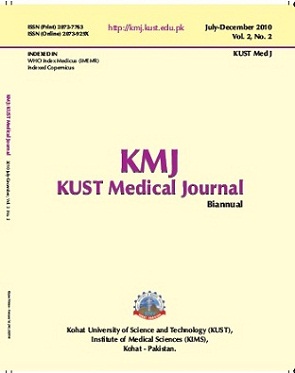FLOOD RELATED HEALTH ISSUES IN PAKISTAN
Main Article Content
Abstract
July 2010 was a month of natural disaster for Pakistan, when torrential monsoon rains led to the worst-ever floods in the history of Pakistan. This natural calamity affected more than 20 million people across the country and led to more than 2000 deaths initially. The death toll is feared to be climbing as the medical repercussions of the floods are adding to the agony of the flood victims.
Although the systematic research on flood related mortality and morbidity is very limited,1 almost 2/3rd of deaths are from drowning or trauma during the floods.2,3
Many people are subjected to drownings during vehicle driving in floods as vehicles are swept away by floodwaters. The mortality rate is affected by various characteristics of the flood including scale and duration, the suddenness of onset, the velocity and depth of water and the lack of warning.2,4 Flash floods (a rapid flooding of geomorphic low-lying areas) are more hazardous than slow-onset floods.5 Men are more vulnerable to flood related deaths than women,2 and people between the ages of 10 and 29 and above 60 years of age are more at risk to die of floods.5
Non-fatal injuries due to trauma are at times very serious and the severity of morbidities
can not be accurately estimated. An alarming fact highlighted by Jonkman SN et al,2 is that about one third of flood related deaths are not related to drowning. It means that these fatalities are preventable and there is a dire need to explore the underlying risk factors of these unfortunate deaths. Besides mortalities, much serious morbidities can also be prevented if prompt and effective measures are taken in time.
The major contributing factor for these hazards is the collapse of local infrastructure by the catastrophic disaster. This may include flood damage to the local hospital buildings and equipment, flood damage to roads and other transport means; problems with drainage and sewerage and damage to water supply systems.
Floods may lead to contamination of un-protected water sources like wells and surface water sources by industrial, human and animal wastes. This contaminated, unsafe and unhygienic water is widely used for drinking and cooking purposes and is mainly responsible for water borne diseases among the flood victims. Water purification tablets and water treatment plants for purification of drinking water along with better sanitation services can reduce the burden of these diseases in the flood affected communities.
Outbreak of communicable diseases is the main flood related health issue in our set up. Various diseases transmitted during flood disasters are usually classified into water-borne and vector-borne diseases. The most common water-borne diseases include typhoid fever, cholera, leptospirosis and hepatitis A. Other diseases transmitted by orofaecal route include nonspecific diarrhea, cryptosporidiosis, poliomyelitis, rotavirus infections and paratyphoid. The main vector-borne diseases include malaria, dengue/dengue haemorrhagic fever, yellow fever, and West Nile Fever. Some rodent borne diseases like leptospirosis and Hantavirus pulmonary syndrome may also increase during floods because of altered patterns of contact.3
Polluted flood waters can lead to rise in some other infections like dermatitis, conjunctivitis, upper and lower respiratory tract infections. Snake bites, wound infections and tetanus are also common in the flood affected areas. In children, hypothermia is also a major concern besides other gastrointestinal and chest diseases. Psychiatric disorders like anxiety and depression are common and may last for months and years after the flood.6
Long term mental health effects like post-traumatic stress disorders (PTSD) can be seen in flood victims having some residual memories of catastrophic nature.7 The environmental hazards, electrocution, gas leakage and chemical hazards are also some of the main risks to the human life in flood affected areas. Similarly, post-flood clean-up operation in severely affected areas may also be dangerous at times. There are few organizations like National Disaster Management Authority (NDMA), health department and some other governmental and non-governmental organizations (NGOs) working for post disaster management of these issues. However, we feel that there is a lack of coordination among these organization resulting in haphazard and ineffective measures. We need a comprehensive and well-coordinated national action plan for disaster management, with equal emphasis on pre-disaster planning, emergency management during disaster and post-disaster rehabilitation. The proposed action plan based on preparedness, response and recovery system can be more useful in reducing damage to human life and economy of the country.
Article Details
Work published in KMUJ is licensed under a
Creative Commons Attribution 4.0 License
Authors are permitted and encouraged to post their work online (e.g., in institutional repositories or on their website) prior to and during the submission process, as it can lead to productive exchanges, as well as earlier and greater citation of published work.
(e.g., in institutional repositories or on their website) prior to and during the submission process, as it can lead to productive exchanges, as well as earlier and greater citation of published work.
